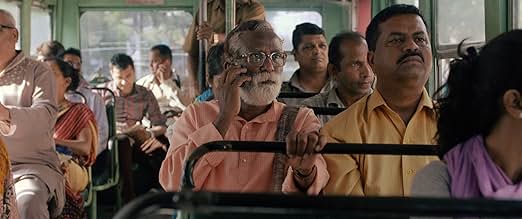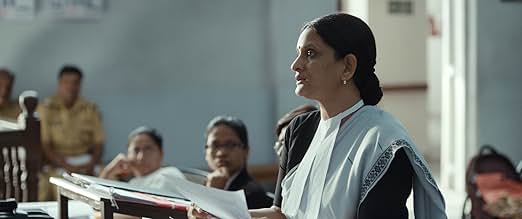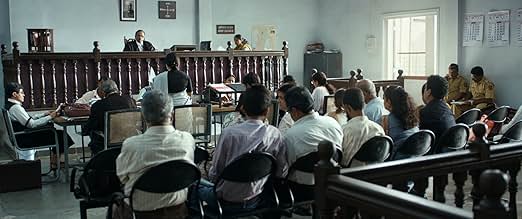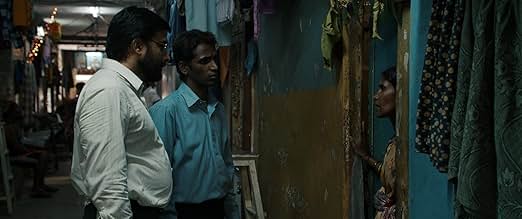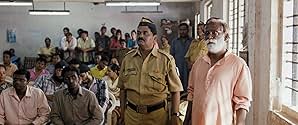IMDb रेटिंग
7.6/10
5.5 हज़ार
आपकी रेटिंग
जब एक बूढ़े कार्यकर्ता को गिरफ्तार किया जाता है, तो अभियुक्तों, वकीलों और न्यायाधीश के जीवन में न्यायिक व्यवस्था को रेखांकित करने वाले कट्टरता को प्रकट करने के लिए हस्तक्षेप होता है.जब एक बूढ़े कार्यकर्ता को गिरफ्तार किया जाता है, तो अभियुक्तों, वकीलों और न्यायाधीश के जीवन में न्यायिक व्यवस्था को रेखांकित करने वाले कट्टरता को प्रकट करने के लिए हस्तक्षेप होता है.जब एक बूढ़े कार्यकर्ता को गिरफ्तार किया जाता है, तो अभियुक्तों, वकीलों और न्यायाधीश के जीवन में न्यायिक व्यवस्था को रेखांकित करने वाले कट्टरता को प्रकट करने के लिए हस्तक्षेप होता है.
- पुरस्कार
- 21 जीत और कुल 10 नामांकन
Sukhdas Suryawanshi
- Sukhdev (court staff)
- (as Sukhdas Suryawamshi)
फ़ीचर्ड समीक्षाएं
An avid Hindi film lover has a quite interesting but unreal picture of an Indian courtroom in his mind full of phrases such as My Lord, Judge Sahib, Objection sustained, Objection Overruled, Order Order, Mere Kaabil Dost, Mr. Public Prosecutor, Case Ki Agli Sunvaayi, Tareekh Pe Tareekh and many more.
However the truth remains shockingly contradicting to the on screen presentation and that's exactly what you get to witness in Chaitanya Tamhane's exceptional directorial debut in Marathi Cinema having an interesting cast ensemble and an explosive subject. Based on a completely unbelievable case filed by the State against an old age artist, admittedly the film takes its own times to influence the viewers with a slow paced story progression, resembling the way court cases keep crawling in India till years or even decades. But remaining within this off-beat framework, COURT also makes you feel many painful blows one after another while watching the case proceedings in a strange state of amazement. And further paints a hugely upsetting picture of our present Police and Judicial system forcing you to wonder that how come this brutally honest film was awarded a National recognition by the Government of India itself ..instead of getting banned.
To make your realize the mistake you would be committing by missing it, here are its major exceptional features that might influence you to change your mind and watch it at the earliest in the coming days.
1. You must have seen many films revolving around a false case being filed by the Police officials against an innocent person. But can you believe the height of absurdity when an investigating officer files a case against a 65 years old revolutionary social activist/artist/writer/singer, with a charge that one of his songs talking about suicide, provoked a poor sewage worker to kill himself by getting drowned in the gutter full of hazardous gases.
2. The case not only gets duly filed by presenting more than one witnesses, but it also gets extensively discussed within the court with the lady lawyer reading out many long pages full of false accusations adding a fine touch of black humour that instantly makes you laugh at the absurdity being practiced within the court itself.
3. The sequences bravely expose the flaws in our police and judiciary system when the police officer has no clues about a letter and existence of one crucial witness but still tries to defend his irresponsible actions so casually. Besides one feels disgustingly surprised when the honourable judge refuses to hear the next case as the lady coming forward is wearing a sleeveless dress that is considered to be disrespectful attire in a court room.
4. Through its various references of the weird case and personal lives of both the lawyers fighting it spiritedly, COURT also mocks at the widely prevalent class divide in our society and issues such as freedom of expression, fake arrests and exploitation of laws by the lawyers themselves ignoring the innocent lives and families being affected severely.
5. The language is a mix of Marathi, English, Hindi and Gujarati too, exactly like you find in the region of Mumbai. Reading the above features, you can easily guess that COURT is a rare thought provoking treat coming from our Regional Indian Cinema.
So just go for it at the earliest and don't miss many small but important real life insertions in its brilliant on screen execution such as:
A. The way the lawyer's parents treat a stranger visiting their house, who happens to be their son's client.
B. The strange, unconcerned kind of attitude in the answers given by the dead worker's widow in the court, who later refuses to take any money as help but asks for some work from the lawyer dropping her home.
C. The particular shot of a printing press, where the police officer arrives to arrest the artist checking his new book being printed, but the press worker sitting just a few feet away continues with his work of compiling a magazine pages showing no concern at all.
D. Just study the way, most of the film has been shot with all still frames with the camera placed in a single position making it more real as if one is sitting right there in the theater witnessing the court's proceedings.
E. And then, many shots continuing to a much longer duration than required with nothing happening on the screen, results in the viewer feeling more involved with the characters and their helpless plight.
In the performances, all inspiring actors (non-professionals mostly) provide a big support to the film led by Vivek Gomber as the defence attorney (also the film's producer), Geetanjali Kulkarni as the public prosecutor, Vira Sathidar as the accused artist/social activist and Pradeep Joshi as the judge. But the choice of other non-actors appearing in very short roles throughout the film could have been better.
The film ends with the final 10 minutes revolving around the judge alone and the stress he feels, leaving the viewers with many uncomfortable and horrifying questions about the court-procedures running in their minds. And perhaps the climax (showing him enjoying a picnic with his family, slapping one of the kids for disturbing his sleep), also wishes to present a possible conclusion that after all even a judge is a human too who does have his own personal life, choices and limitations.
In fact that's exactly what makes COURT a highly recommended movie for all thinking minds. So whatever language or region you belong to, shed all your reservations of watching a regional movie with English subtitles and do yourself a favour witnessing COURT at the earliest as its indeed yet another important benchmark set by the Marathi film-makers in our rich Indian cinema undoubtedly.
However the truth remains shockingly contradicting to the on screen presentation and that's exactly what you get to witness in Chaitanya Tamhane's exceptional directorial debut in Marathi Cinema having an interesting cast ensemble and an explosive subject. Based on a completely unbelievable case filed by the State against an old age artist, admittedly the film takes its own times to influence the viewers with a slow paced story progression, resembling the way court cases keep crawling in India till years or even decades. But remaining within this off-beat framework, COURT also makes you feel many painful blows one after another while watching the case proceedings in a strange state of amazement. And further paints a hugely upsetting picture of our present Police and Judicial system forcing you to wonder that how come this brutally honest film was awarded a National recognition by the Government of India itself ..instead of getting banned.
To make your realize the mistake you would be committing by missing it, here are its major exceptional features that might influence you to change your mind and watch it at the earliest in the coming days.
1. You must have seen many films revolving around a false case being filed by the Police officials against an innocent person. But can you believe the height of absurdity when an investigating officer files a case against a 65 years old revolutionary social activist/artist/writer/singer, with a charge that one of his songs talking about suicide, provoked a poor sewage worker to kill himself by getting drowned in the gutter full of hazardous gases.
2. The case not only gets duly filed by presenting more than one witnesses, but it also gets extensively discussed within the court with the lady lawyer reading out many long pages full of false accusations adding a fine touch of black humour that instantly makes you laugh at the absurdity being practiced within the court itself.
3. The sequences bravely expose the flaws in our police and judiciary system when the police officer has no clues about a letter and existence of one crucial witness but still tries to defend his irresponsible actions so casually. Besides one feels disgustingly surprised when the honourable judge refuses to hear the next case as the lady coming forward is wearing a sleeveless dress that is considered to be disrespectful attire in a court room.
4. Through its various references of the weird case and personal lives of both the lawyers fighting it spiritedly, COURT also mocks at the widely prevalent class divide in our society and issues such as freedom of expression, fake arrests and exploitation of laws by the lawyers themselves ignoring the innocent lives and families being affected severely.
5. The language is a mix of Marathi, English, Hindi and Gujarati too, exactly like you find in the region of Mumbai. Reading the above features, you can easily guess that COURT is a rare thought provoking treat coming from our Regional Indian Cinema.
So just go for it at the earliest and don't miss many small but important real life insertions in its brilliant on screen execution such as:
A. The way the lawyer's parents treat a stranger visiting their house, who happens to be their son's client.
B. The strange, unconcerned kind of attitude in the answers given by the dead worker's widow in the court, who later refuses to take any money as help but asks for some work from the lawyer dropping her home.
C. The particular shot of a printing press, where the police officer arrives to arrest the artist checking his new book being printed, but the press worker sitting just a few feet away continues with his work of compiling a magazine pages showing no concern at all.
D. Just study the way, most of the film has been shot with all still frames with the camera placed in a single position making it more real as if one is sitting right there in the theater witnessing the court's proceedings.
E. And then, many shots continuing to a much longer duration than required with nothing happening on the screen, results in the viewer feeling more involved with the characters and their helpless plight.
In the performances, all inspiring actors (non-professionals mostly) provide a big support to the film led by Vivek Gomber as the defence attorney (also the film's producer), Geetanjali Kulkarni as the public prosecutor, Vira Sathidar as the accused artist/social activist and Pradeep Joshi as the judge. But the choice of other non-actors appearing in very short roles throughout the film could have been better.
The film ends with the final 10 minutes revolving around the judge alone and the stress he feels, leaving the viewers with many uncomfortable and horrifying questions about the court-procedures running in their minds. And perhaps the climax (showing him enjoying a picnic with his family, slapping one of the kids for disturbing his sleep), also wishes to present a possible conclusion that after all even a judge is a human too who does have his own personal life, choices and limitations.
In fact that's exactly what makes COURT a highly recommended movie for all thinking minds. So whatever language or region you belong to, shed all your reservations of watching a regional movie with English subtitles and do yourself a favour witnessing COURT at the earliest as its indeed yet another important benchmark set by the Marathi film-makers in our rich Indian cinema undoubtedly.
Chaitanya Tamhane's Court approaches many fascinating and bitingly topical subjects for a constantly changing India. When those to the west think of India, we often imagine the hustle and bustle depicted in Slumdog Millionaire coupled with the energy and glittery elegance of Bollywood movies. Court is a slower burn with incredible wide cinematography that captures a disquieting stillness. It's almost like a political thriller where no-one can be trusted, but it's not a film that relies on tension or conclusions. It studies the westernisation of Indian culture through its network of characters, darting between the folk singer Sharmila Pawar and his 'Americanised' defence lawyer Vinay Voya, but without peeling back their layers. It's not interested in the characters as people but what they represent in the situation, wherein Pawar is being tried for inciting a man to suicide through his songs.
Instead, it contrasts the old with the new, with Indian traditions and the updates of the youths, aesthetically and with their behaviour. The courtroom drama prods at this aspect with old laws being questioned for being outdated and how they should be reconsidered. It seems a lack of compromise is also part of tradition and is something that contemporary Indians wants to implement. The film also studies the effect of art, questioning whether folk music can really change a government and if it does influence bad things incidentally, can it be held accountable? The power of poetry is a strange thing in a world drenched in culture. What counts as a performance when art is so fluid? Where do we draw the line between coincidence and crime? Court is a very dry but very thought-provoking and highly intelligent film that raises important questions about the world we live in, albeit it could've been improved by a bit more character work and a concise ending.
8/10
Read more @ The Awards Circuit (http://www.awardscircuit.com/)
Instead, it contrasts the old with the new, with Indian traditions and the updates of the youths, aesthetically and with their behaviour. The courtroom drama prods at this aspect with old laws being questioned for being outdated and how they should be reconsidered. It seems a lack of compromise is also part of tradition and is something that contemporary Indians wants to implement. The film also studies the effect of art, questioning whether folk music can really change a government and if it does influence bad things incidentally, can it be held accountable? The power of poetry is a strange thing in a world drenched in culture. What counts as a performance when art is so fluid? Where do we draw the line between coincidence and crime? Court is a very dry but very thought-provoking and highly intelligent film that raises important questions about the world we live in, albeit it could've been improved by a bit more character work and a concise ending.
8/10
Read more @ The Awards Circuit (http://www.awardscircuit.com/)
Chaitanya Tamhane's directorial debut, Court, is a multilingual, award- winning film on the "quiet violence" of the judicial system and how the State uses it to suppress political activists. Financed by the Hubert- Bals Fund and private equity, it opened to rave reviews and won Best Director and Best Film in the International Competition section of the 16th Mumbai Film Festival. It also premiered at the Venice Film Festival earlier in the year, where it won the Lion of the Future Award for the best first feature. Court successfully invokes the mood of a trial based on patently ridiculous charges, conducted with no intent other than disciplining and harassment of an activist. A phenomenon that is all too common in India. The theme is very timely given the increasingly intolerant nature of the Indian State and the large number of political prisoners languishing in jail all across the country.
The film follows the trial of Narayan Kamble (Vira Sathidar), a Dalit political activist and lokshahir (people's poet) who is arrested on stage during a performance in Bombay on charges of "abetment of suicide." The police claim that Kamble has penned and performed "incendiary" lyrics calling on Dalits to "drown themselves in sewage" provoking a municipal sanitation worker to actually take his own life by drowning in the very sewer it is his duty to clean. The absurdity of the charge is matched by the (mock?) seriousness with which it is pursued but the police and the officials of the Sessions court. While the politics of false charges and suppression of activists via legal means is an important theme in the film, Tamhane also uses the context of the trial to explore the everyday lives of the principal actors in the courtroom; especially the lawyers for defense (producer Vivek Gomber) and prosecution (played by Geetanjali Kulkarni), and the judge (Pradeep Joshi). What emerges is how extraordinary injustice is embedded in quotidian affairs. The prosecution lawyer argues against bail, ensures that an honest man of advanced years rots in police custody for no reason at all and then goes home to cook dinner and watch TV with her family.
The ponderous legal system is certainly the main protagonist, as is evident in the name of the film. And as a useful counterpoint to the brilliant and satirical Mohan Joshi Hazir Ho, Court forces us confront the fact that the byzantine alleyways of justice and the proverbial tarikh pe tarikh, are not merely the unintended result of an uncaring and bureaucratic system but rather used deliberately by the State to remove its more inconvenient citizens for some time, say three or four years. At which time it is the headache of the next set of rulers.
See the full review at: http://sanhati.com/excerpted/11761/
The film follows the trial of Narayan Kamble (Vira Sathidar), a Dalit political activist and lokshahir (people's poet) who is arrested on stage during a performance in Bombay on charges of "abetment of suicide." The police claim that Kamble has penned and performed "incendiary" lyrics calling on Dalits to "drown themselves in sewage" provoking a municipal sanitation worker to actually take his own life by drowning in the very sewer it is his duty to clean. The absurdity of the charge is matched by the (mock?) seriousness with which it is pursued but the police and the officials of the Sessions court. While the politics of false charges and suppression of activists via legal means is an important theme in the film, Tamhane also uses the context of the trial to explore the everyday lives of the principal actors in the courtroom; especially the lawyers for defense (producer Vivek Gomber) and prosecution (played by Geetanjali Kulkarni), and the judge (Pradeep Joshi). What emerges is how extraordinary injustice is embedded in quotidian affairs. The prosecution lawyer argues against bail, ensures that an honest man of advanced years rots in police custody for no reason at all and then goes home to cook dinner and watch TV with her family.
The ponderous legal system is certainly the main protagonist, as is evident in the name of the film. And as a useful counterpoint to the brilliant and satirical Mohan Joshi Hazir Ho, Court forces us confront the fact that the byzantine alleyways of justice and the proverbial tarikh pe tarikh, are not merely the unintended result of an uncaring and bureaucratic system but rather used deliberately by the State to remove its more inconvenient citizens for some time, say three or four years. At which time it is the headache of the next set of rulers.
See the full review at: http://sanhati.com/excerpted/11761/
RATED 8/10
Language: Marathi
Source: Netflix
RECOMMENDED
Well crafted drama about court room and the persons in court room. Too much of artistic and slow but its perfect.
The real life and court life of different characters and their views of personal and court life.... the climax is the big slap on citizen's face... the last 15 seconds tells the story with superb impact.... Must watch...
The real life and court life of different characters and their views of personal and court life.... the climax is the big slap on citizen's face... the last 15 seconds tells the story with superb impact.... Must watch...
Saw this at the Rotterdam film festival 2015 (IFFR), where it was part of the Bright Future section (and indeed, it deservedly belonged in that section). In short: Very well done, in all respects. We get an inside view in the Indian legal system and also in normal life there, the latter while we follow opposing council and see how they live outside the court. And in the final scene, when the case is all over, we also follow the judge on a family trip. This final scene is somewhat detached from the core story, but its purpose becomes clear when seeing the judge on a holiday trip in family circles. It seemed a loose end, but fits nicely in the setup, after all.
The Indian legal system is portrayed very well and (as far as I can see) objectively, not leaving a bad impression behind. Prosecution and defense council act believably and competently, and each gets their say. The judge on his side goes strictly by the book. That being his role in the proceedings, I have no problem with him either. The police force is portrayed less positive, if not merely incompetent, showing tunnel vision when locating suspects and witnesses. Interestingly, typically Indian I assume, we see laws quoted from the colonial age. This is remarkable but apparently a fact of contemporary Indian life. And, as judge agrees with prosecution, it IS current law hence applies in this case. In the final Q&A, the director confirms that many laws are outdated, requiring interpretation to establish what they really mean nowadays.
I noted two loose facts from the Q&A. Firstly, the slum area we see when one of the witnesses is brought back to her family, looks true to reality. Nearly demolished places like that coexist in the same city. Secondly, as far as the actors are concerned, we learn that 90% was non-professional. For that reason, Narayan's songs are playbacked.
To conclude: Some people in Western countries may find nearly two hours running time overly long, but it did not feel that way. I think that is caused by mixing court scenes with family scenes outside the court room. As such, we see the formal proceedings indoors next to what happens outdoors in personal lives of councils and judge. Intermixing these two worlds works very well. Indeed, the story seems to drag some of the time, just like the actual court case does, but it did not hinder me at all, as there were ample developments, and last-but-not-least interesting local folklore that we would never had the chance to see if not through this movie.
The Indian legal system is portrayed very well and (as far as I can see) objectively, not leaving a bad impression behind. Prosecution and defense council act believably and competently, and each gets their say. The judge on his side goes strictly by the book. That being his role in the proceedings, I have no problem with him either. The police force is portrayed less positive, if not merely incompetent, showing tunnel vision when locating suspects and witnesses. Interestingly, typically Indian I assume, we see laws quoted from the colonial age. This is remarkable but apparently a fact of contemporary Indian life. And, as judge agrees with prosecution, it IS current law hence applies in this case. In the final Q&A, the director confirms that many laws are outdated, requiring interpretation to establish what they really mean nowadays.
I noted two loose facts from the Q&A. Firstly, the slum area we see when one of the witnesses is brought back to her family, looks true to reality. Nearly demolished places like that coexist in the same city. Secondly, as far as the actors are concerned, we learn that 90% was non-professional. For that reason, Narayan's songs are playbacked.
To conclude: Some people in Western countries may find nearly two hours running time overly long, but it did not feel that way. I think that is caused by mixing court scenes with family scenes outside the court room. As such, we see the formal proceedings indoors next to what happens outdoors in personal lives of councils and judge. Intermixing these two worlds works very well. Indeed, the story seems to drag some of the time, just like the actual court case does, but it did not hinder me at all, as there were ample developments, and last-but-not-least interesting local folklore that we would never had the chance to see if not through this movie.
क्या आपको पता है
- ट्रिवियाSome cast members were untrained, non-professional actors. In the case of the woman who plays the deceased's widow, it's eerie how unaffected the scene is before you realize that it's reality. (The woman is widowed in real life. Her husband was a manhole worker.)
- साउंडट्रैकDhanya Dhanya Tumhi Sarkar
Written and performed by Sambhaji Bhagat
टॉप पसंद
रेटिंग देने के लिए साइन-इन करें और वैयक्तिकृत सुझावों के लिए वॉचलिस्ट करें
- How long is Court?Alexa द्वारा संचालित
विवरण
बॉक्स ऑफ़िस
- US और कनाडा में सकल
- $22,898
- US और कनाडा में पहले सप्ताह में कुल कमाई
- $4,806
- 19 जुल॰ 2015
- दुनिया भर में सकल
- $57,416
इस पेज में योगदान दें
किसी बदलाव का सुझाव दें या अनुपलब्ध कॉन्टेंट जोड़ें







